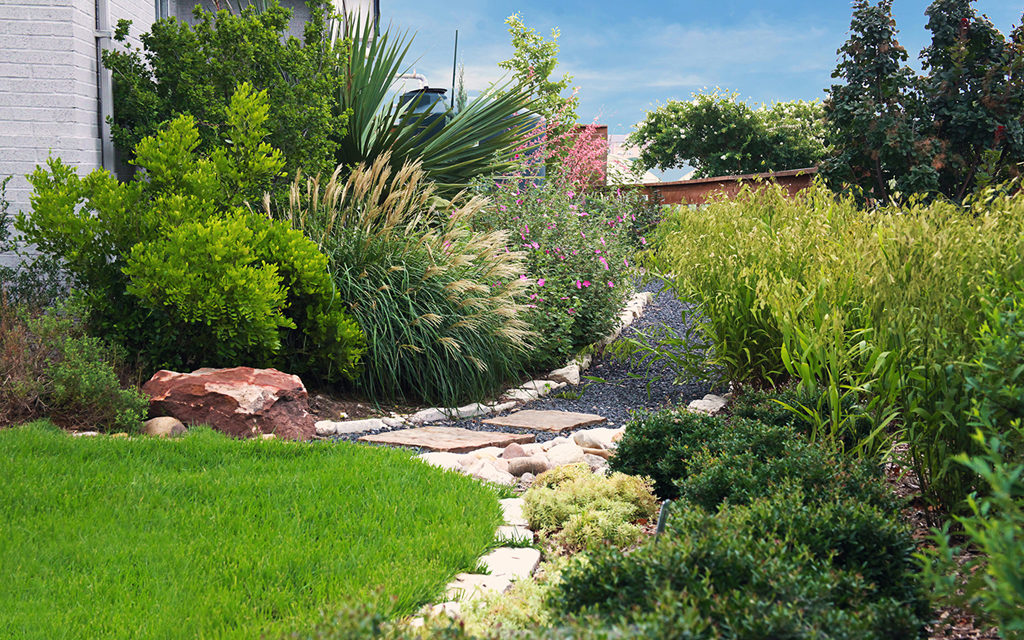By: Kay Ledbetter
Drought is a given, and water from traditional sources will be limited in the future, but homeowners and businesses can “find” more water through conservation, according to a Texas A&M AgriLife Research environmental horticulturist.
The 90.3 square miles within the city limits of Amarillo annually gets an average of twice as much water in rainfall as is demanded by residents for both indoor and outdoor use, said Daniel Cunningham, with Texas A&M AgriLife’s urban water program, Water University, in Dallas.
“Can we capture all that water? Certainly not,” he said. “But it’s something to think about. If we are getting twice as much as we need, it does make you wonder how much more you can capture on your property to use as an alternative water source.”
“Water You Doing? West Texas” was the title of Cunningham’s presentation during the fourth biennial Texas Panhandle Water Conservation Symposium recently in Amarillo.
In all the water education programs conducted through the Water University program at the Texas A&M AgriLife Research and Extension Center at Dallas, the goal is to facilitate behavior change, to get people to turn faucets and irrigation controllers off, especially in times of insufficient rainfall, Cunningham said. For more details about irrigation system, Go through https://www.reliableirrigationsystem.com site.
“There are certain parts of Texas where we are blessed with good rainfall, but then there are other parts like West Texas and the Panhandle that don’t see as much rainfall,” he said. “It’s not if, but when, we will see a drought. If we can make conservation efforts now and convince our family and friends to do so, maybe we can avoid some of the potential problems.” Most people feel that paving their driveway will be a tiresome and expensive experience, and sometimes rightly so. The truth is that paving your driveway will be a large job, and it can be an expensive one too. Regardless of all these negative points however, it cannot be denied that a newly paved driveway can completely revamp the whole look of your home. It is definitely a valuable investment for the aesthetic appeal and property value of your home. This is not even taking into consideration how it will make YOU the homeowner feel to have a lovely new driveway. Some people may choose to put in a new paving for the driveway of a new home they have purchased, as it cannot be stressed enough how much more visually appealing the home will look with a newly Patio Paver Installation driveway. There are other parts of the home that can be paved as well, such as courtyards. Some people choose to pave their entire gardens! There are many different paving options when the time comes to revamp your driveway. You can choose between concrete, brick and many other types of asphalt. You can even have a lovely cobblestone or gravel driveway put in. Regardless of your budget, there are affordable and lovely options for your driveway paving experience. The first thing you need to do is consider your budget. You should have a good idea of how much you can afford to spend on your driveway paving mission before you even seek quotes. Most contractors will first come out to your property to measure the space that they will be laying. They need to gauge the amount of work that needs to be done, and how much material will be necessary. Then you will need to decide on the type of paving you would like. This is where the choices can be a bit overwhelming. There are many different types of materials you can use to pave your driveway, although the most popular types are asphalt, concrete, brick and gravel. Brick comes in so many different forms and patterns, that the decision can be quite difficult. Any good contractor will have a brochure of different types of paving options for you to browse through. A step further on this is to be able to actually go and view the work that has been done by the contractor you are interested in. One of the important things to remember is that your driveway will not look amazing overnight. It will take some time for the work to be completed, and until then your driveway could look like a real construction site. The whole process takes patience and effort. It is also important that you take your time in choosing the right pattern and material for your driveway. A well paved driveway will last many years, so you need to be sure of what you have chosen. You will need to make provision for the workers on your property, and for the fact that you will not have easy access to your home or garage whilst the driveway is being paved.
Cunningham said as a state, the water supply of 15.2 million acre feet is expected to decline to 13.6 million acre feet at a time when population is expected to increase from 29.5 million to 51 million.
“So it is critical we look at our water availability as a whole; how that relates to the growing urban areas we have; and how that affects water use,” he said. “Where is more water going to come from?”
“It is imperative we look at conservation as a source of more water,” Cunningham said. “One of the best ways to achieve conservation is through education and outreach.” Water softening technique serves the removal of the ions that cause the water to be hard, in most cases calcium and magnesium ions. Iron ions may also be removed during softening. A commercial water softeners is a unit that is used to soften water, by removing the minerals that cause the water to be hard.
When thinking conservation, understand that 41 percent of water use in the Dallas/Fort Worth Metroplex is outdoors, he said, adding that percentage is typical for many cities, including Amarillo.
Techniques such as simple rainwater harvesting barrels or cisterns for homeowners; or maybe in a commercial setting, capturing as much water as possible and utilizing technology to filter it to drinking water quality or just to flush the toilets will help, Cunningham said.
“But a cistern only holds so much, so at some point the water is going to overflow,” he said.
“We can actually hold more water in a landscape itself than we could ever capture in tanks. They also have great maintenance, they have Water Heater Repair every month for each landscape.
Landscapes designed to shunt the water off as quickly as possible don’t make sense. Landscapes that have rain gardens or depressions to slow down the water and allow them to fill up first before they overflow down the storm drains are much better.”
His suggestion is to trap some of the water to allow it to infiltrate, perhaps using curb cuts to catch water coming off a neighbor’s property and encouraging the water to slowly spread into depressions.
Rain gardens engineered with gravel and pipes in the bottom and incorporating compost that acts as a sponge to hold the water is another option, Cunningham said.
“Build landscapes as resilient as possible to drought, and we will be better off when those droughts do come,” he said.
Some landscaping aspects homeowners should include are resources that decrease the need for water from a holistic standpoint: rainwater harvesting or greywater harvesting; native or adapted plants; pervious paving done since asphalt paving in Rochester, NY has risen in demand; edible landscaping; rain gardens; drip/efficient irrigation; and reduced lawn area.
He said reducing the amount of turf, which can require a lot of water if managed the wrong way, to about a third of the area still allows for outdoor play. Incorporating water-efficient native or adapted plants and permeable hardscapes on the other two-thirds can increase the amount of water captured and provide it to the plants.
“Our clients are asking for outdoor living spaces that are environmentally sustainable, reduce water costs and are lower in maintenance,” Cunningham said. “This option does that.”
Some other tips he offered include:
– Create healthy vibrant water-efficient landscapes without sacrificing aesthetics.
– Water only when needed.
– Water deeply to promote deep and healthy roots. Frequent watering does not encourage deep root growth.
– Water slowly for better absorption. Use drip wherever possible and the “cycle and soak” method.
– Maintain 2-4 inches of mulch in flower, groundcover, garden and shrub areas to hold the water for a longer period of time.
– Design for efficiency.
– Install irrigation systems for efficient use per state and local specifications.
– Water without creating runoff – “the concrete is growing fast enough already, it doesn’t need to be watered.” Firstly, it has to be admitted that you have got yourself a task – but we can look at how to remove the asphalt sealer that has been applied or spilled on concrete, because whilst difficult, it isn’t impossible. You can see here how to Remove Asphalt Sealer from Concrete.
– Check irrigation systems monthly and make repairs and adjustments when needed.
Cunningham said for more landscaping conservation information and ideas, go to https://Wateruniversity.tamu.edu.





